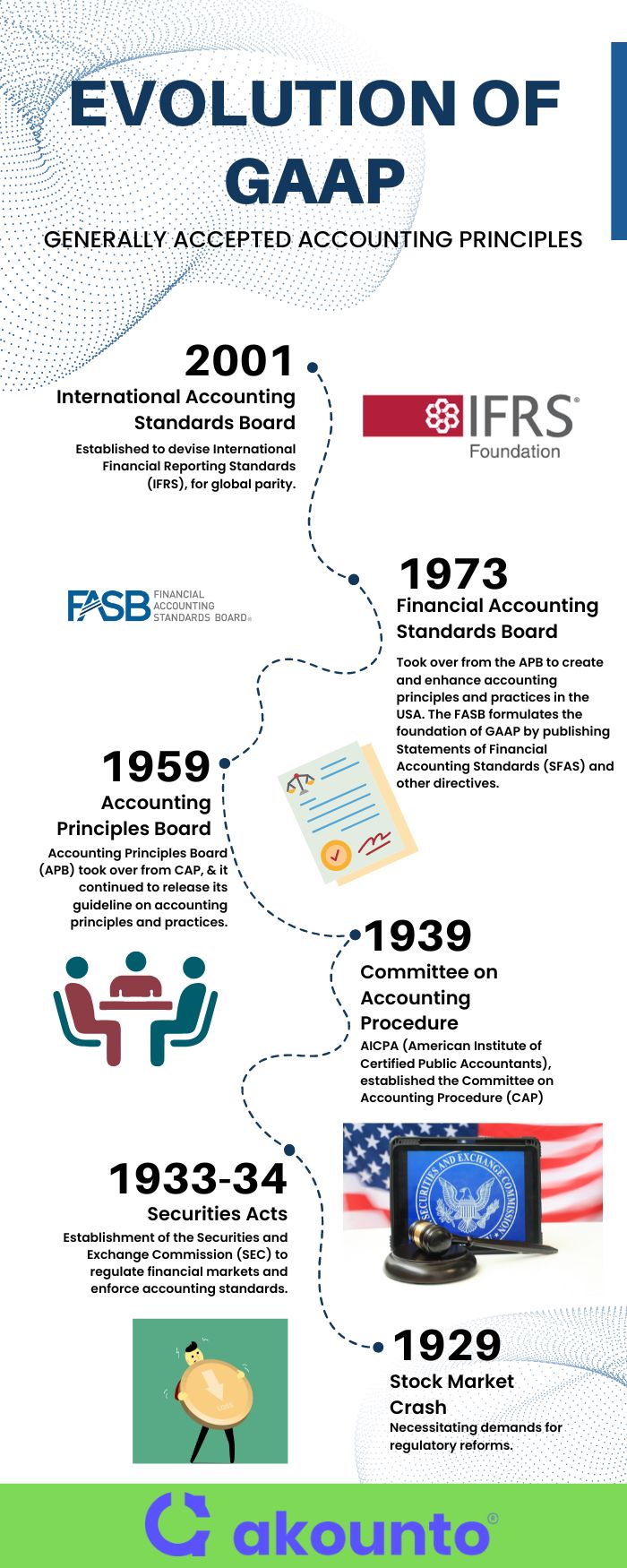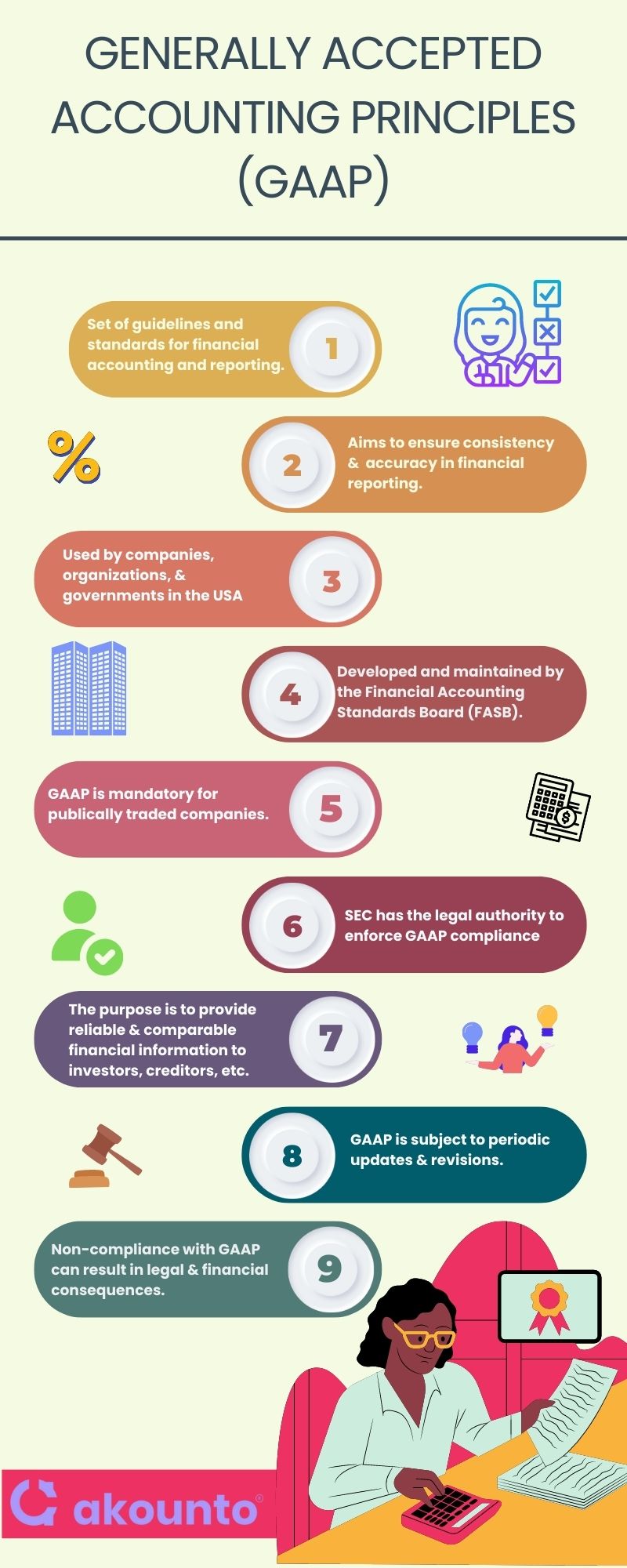What are Generally Accepted Accounting Principles?
US GAAP is standardized guidelines and frameworks outlining accounting practices and financial reporting standards for companies in the USA.
Generally Accepted Accounting Principles (GAAP) give a common framework for companies to prepare and present their financial statements, ensuring consistency, transparency, and comparability across different organizations.
US GAAP and Accounting Standards
Accounting Standards and US GAAP (Generally Accepted Accounting Principles)are interconnected frameworks directing financial reporting and accounting practices.
US GAAP is a broad set of accounting principles solely applicable to United States entities and is administered by the Financial Accounting Standards Board (FASB).
Accounting Standards are broader terms encompassing guidelines and rules given by regulatory bodies globally, such as the IASB (International Accounting Standards Board), which governs IFRS (International Financial Reporting Standards) practices.
GAAP and US GAAP share some similarities but are not the same. US GAAP is a subset of GAAP specific to the United States, and it includes additional accounting principles and standards unique to the U.S. business environment.
Importance
Generally Accepted Accounting Principles are the foundation of accounting and financial reporting, fostering investor confidence, enabling informed decision-making, and ensuring a level playing field for all stakeholders. Its significance can be highlighted in several ways:
- Regulatory Compliance: In line with Securities and Exchange Commission (SEC) regulations, compliance with GAAP is a legal requirement for publicly traded companies in the United States. Adhering to GAAP helps businesses avoid legal and financial penalties while maintaining their market reputation.
- Easy Financing: Adhering to GAAP standards increases the likelihood of companies securing financing from banks and other financial institutions because it showcases their dedication to transparent and dependable financial reporting.
- Reliability: The implementation of GAAP guidelines guarantees the preparation of financial reports utilizing reliable and standardized accounting guidelines. This consistency reinforces the authenticity of financial statements, thereby instilling trust in stakeholders to rely on the presented financial data.
- Enabling Comparison: GAAP is a standardized set of accounting principles and guidelines that ensures financial statements are consistent across organizations. This uniformity enables investors, creditors, and regulators to accurately compare the financial performance of various companies, facilitating informed decision-making.
- Transparency: Through adherence to GAAP, companies are obligated to divulge relevant financial data and information in a transparent and all-inclusive manner. This transparent disclosure enables stakeholders to evaluate the financial stability of the company, identify possible risks, and make sound investment decisions with a high degree of certainty.
History and Evolution

Since the early twentieth century, the development of Generally Accepted Accounting Principles (GAAP) has been a continuous process driven by the need for standardization and transparency in financial reporting.
The evolution of GAAP can be understood through key milestones in its history:
- Stock Market Crash (1929): The Great Depression brought to light the inadequacy of prevailing accounting practices and emphasized the necessity of uniform accounting standards. The absence of standardized and transparent accounting principles eroded investor confidence, thereby necessitating demands for regulatory reforms.
- Securities Acts of 1933 and 1934: In response to the Great Depression, the U.S. Congress passed the Securities Act (1933) and the Securities Exchange Act (1934) to establish the Securities and Exchange Commission (SEC) to regulate financial markets and enforce accounting standards for public companies.
- Committee on Accounting Procedure (1939): The American Institute of Accountants (AIA), which was later renamed AICPA (American Institute of Certified Public Accountants), established the Committee on Accounting Procedure (CAP). The primary function of CAP was to create accounting principles and disseminate Accounting Research Bulletins (ARBs) to offer recommendations on diverse accounting matters.
- Accounting Principles Board (1959): In 1959, the Accounting Principles Board (APB) took over from CAP, and it continued to release its guideline on accounting principles and practices. Nevertheless, the APB encountered objections for its deficient autonomy and tardy decision-making procedure.
- Financial Accounting Standards Board (1973): The Financial Accounting Standards Board (FASB) is an autonomous institution to take over from the APB. Its primary objective is to create and enhance accounting principles and practices in the United States. The FASB formulates the foundation of GAAP by publishing Statements of Financial Accounting Standards (SFAS) and other directives.
- International Accounting Standards Board (2001): The International Accounting Standards Board (IASB) was established to devise International Financial Reporting Standards (IFRS), which have gained substantial traction among numerous countries globally.
The FASB and IASB have collaborated towards harmonizing GAAP and IFRS, with the aim of producing a single set of superior global accounting standards.
Key Principles

Generally accepted accounting principles are based on a set of basic principles that guide financial reporting and accounting practices.
The key principles ensure that financial statements are consistent, comparable, and transparent across different organizations. The main principles of GAAP include the following:
- Revenue Recognition: Gaap establishes the criteria for recognizing revenue in the company’s financial statements. The income is reported in an accounting period when the revenue is “earned and realized” or “realizable.” ASC 606 is the revenue recognition standard issued by FASB (Financial Accounting Standards Board).
- Matching Principle: To provide an accurate representation of a company’s financial performance, expenses must be recorded in the same accounting period as the revenues they help generate, as required by the matching principle.
- Accrual Basis of Accounting: One of the fundamental principles of GAAP is the use of the accrual basis of accounting. Gaap-compliant financial statements recognize revenues and expenses as they are earned or incurred, irrespective of when cash is received.
- Materiality: According to the “materiality principle,” financial statement items must be disclosed if their omission or misrepresentation may have an impact on users’ economic choices.
- Consistency: The consistency principle states that the same accounting methods, consistent procedures, and continued accounting policies should be followed in every accounting year. The consistency principle enables comparison within the same industry and aids decision-making in corporate accounting.
- Historical Cost: According to the historical cost principle, assets should be valued at their purchase price rather than their market value today (contradiction to the fair market value concept). This rule offers a reliable foundation for asset valuations and promotes objectivity in financial reporting.
- Conservatism: The conservatism principle states that in situations of uncertainty or when confronted with alternative accounting treatments, accountants must opt for the method that is the least likely to overstate assets or income. GAAP aims to ensure that financial statements prepared for reporting do not present an overly optimistic view of a company’s financial position.
- Full Disclosure: As per the full disclosure principle, financial reports must include all pertinent financial information necessary for understanding a company’s financial statements.
- Going Concern: The principle of going concern implies that a business will remain operational and solvent for an indefinite period of time. This presumption forms the basis for financial statement preparation.
It enables stakeholders to make decisions based on the assumption that the business will continue its operations without any imminent financial issues. Read this article to learn about the solvency and liquidity of a business. - Economic Entity: According to the economic entity principle, a company’s financial operations should be kept apart from those of its owners or related parties.
Scope of Generally Accepted Accounting Principles
In order to provide a thorough framework for creating financial statements, generally accepted accounting principles (GAAP) cover a broad range of financial reporting and accounting practices. The following factors can be used to comprehend the scope of GAAP:
- Applicability: GAAP is primarily applicable to publicly traded companies in the United States, as mandated by the Securities and Exchange Commission (SEC). However, private companies and nonprofit organizations often voluntarily adopt GAAP to enhance the credibility of their financial reports.
Under the Securities Act (1933) and the Securities Exchange Act (1934), public companies are required to file regular financial reports with the SEC, including annual reports (Form 10-K) and quarterly reports (Form 10-Q).
The SEC also has the legal authority to enforce GAAP compliance and take action against companies that fail to adhere to GAAP in their financial reporting. - Financial Statements: GAAP provides guidelines for preparing financial statements, including the income statement, balance sheet, cash flow statement, and statement of shareholders’ equity. These guidelines ensure consistent presentation and disclosure of financial data, enabling comparability across different entities.
- Accounting Principles: GAAP encompasses various accounting principles, such as revenue recognition, expense matching, accrual basis of accounting, and materiality. These principles ensure that the reporting process provides a fair and accurate representation of a company’s financial information.
- Financial Reporting Standards: GAAP includes specific financial reporting standards given by the Financial Accounting Standards Board (FASB), such as the FASB Accounting Standards Codification. These standards provide detailed guidance on various accounting and financial reporting topics, such as asset valuations, lease accounting, and pension accounting.
- Governmental Accounting Standards: The Governmental Accounting Standards Board (GASB) is responsible for establishing GAAP for local and federal government entities in the United States.
- Industry-Specific Rules: GAAP also includes industry-specific rules and guidance, addressing unique accounting issues and practices in sectors such as banking, insurance, and utilities. These industry-specific rules ensure that financial statements reflect the unique characteristics and risks associated with each sector.
IFRS GAAP Convergence
The IFRS (International Accounting Standards Board) and FASB (Financial Accounting Standards Board) are responsible for developing International Financial Reporting Standards (IFRS) and GAAP, respectively have been working together to harmonize their respective accounting standards.
The collaboration, known as the IFRS-GAAP convergence, has resulted in numerous joint projects and updates to existing standards. Key milestones in the IFRS-GAAP convergence process include:
- Norwalk Agreement (2002): The FASB and IASB signed the Norwalk Agreement, a memorandum of understanding that committed both organizations to work towards the development of a single set of high-quality, compatible accounting standards.
- Revenue Recognition (2014): The FASB and IASB jointly issued new revenue recognition standards, ASC Topic 606 for US GAAP and IFRS 15 for IFRS, aligning the principles and requirements for recognizing revenue in financial statements.
- Lease Accounting (2016): Both boards updated their lease accounting standards, with FASB issuing ASC Topic 842 for US GAAP and IASB issuing IFRS 16. While some differences remain, these updates brought significant alignment in lease accounting treatment.
Despite progress made in converging IFRS and GAAP, several differences still exist between the two sets of standards. Areas of divergence include inventory costing, impairment of long-lived assets, and development costs, among others.
Complete convergence remains an ongoing challenge, but efforts by the FASB and IASB continue to bring the two frameworks closer together, with the ultimate objective of a single set of international accounting standards.
Accounting Software and GAAP
The use of accounting software can help businesses to streamline their financial management processes, reduce errors, and ensure compliance with GAAP reporting guidelines.
When setting up accounting software, it is important to ensure that the software is designed to capture all relevant financial transactions and to classify them appropriately based on GAAP.
The software should be configured to recognize different types of transactions, such as revenue, expenses, assets, and liabilities, and to assign them to the appropriate accounts and follow double-entry bookkeeping.
Conclusion
GAAP provides a comprehensive framework for financial reporting, ensuring consistency, transparency, and comparability across different organizations. Despite some disadvantages, GAAP remains crucial for maintaining credibility and trust in financial markets.
As efforts continue towards convergence with International Financial Reporting Standards, GAAP will likely evolve to address better the needs of an increasingly globalized and interconnected business environment.




